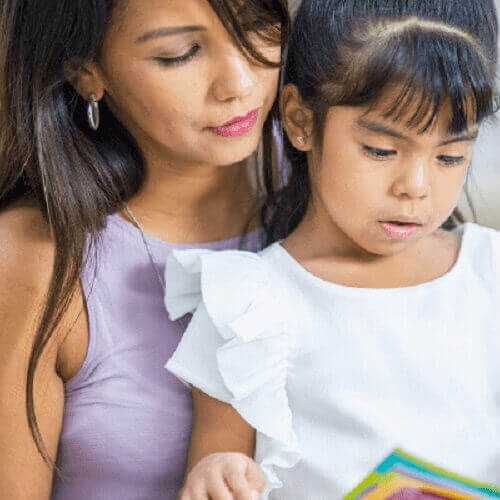A child’s early exposure to language is at the heart of development. Aspects of early language environments have been found to predict language skills, cognitive skills, and academic achievement in previous studies. Language exposure encompasses many elements, and researchers continue to investigate what roles specific features might play.
A recent study identifies a link between one of these features—the amount of conversational back-and-forth between parents and children—and the development of language structures in the brain. The findings shed light on the underlying biology that connects linguistic inputs and cognitive outputs. They also underscore the potential value of policies that address language use early on in the course of development.
“Conversation is really the meat of language development,” says Rachel Romeo, the lead author of the study and a developmental cognitive neuroscientist at the Massachusetts Institute of Technology.
Romeo and her colleagues studied a group of 40 children aged 4 to 6 years old, measuring their cognitive and language skills. They also studied language exposure by outfitting the children with a wristwatch-like device that recorded and parsed speech, such as the number of words children heard and spoke and the number of “conversational turns,” or pairs of remarks exchanged by a parent and child.
The researchers also took MRI scans of each child’s brain. They investigated specific brain structures called white matter tracts, so-called “information highways” that deliver information between brain regions.
They discovered that the more conversation children experienced, the stronger the white matter tracts tended to be between key language regions in the brain: Broca’s area, which is responsible for speech production, and Wernicke’s area, which handles language comprehension. These stronger connections may indicate that the white matter tracts are composed of more neurons or that those neurons are organized more efficiently to transfer information, Romeo says.

The study can’t determine whether conversational turns caused the brain changes, notes Kimberly Noble, an associate professor of neuroscience and education at Columbia University. The genetics that parents and children share, for example, might help explain the correlation between parent-child communication and the measures of children’s brains. However, Noble says, the researchers ruled out a number of other potential factors that might have accounted for the link, including the number of words spoken and sociodemographic characteristics.
The findings add to a larger conversation about the interaction between socioeconomic status and language development. Back in the 1990s, a pair of education researchers, Betty Hart and Todd Risley, published a landmark paper claiming that children from affluent backgrounds hear millions more words by age 3 than their disadvantaged peers do. The concept has become controversial due to methodological concerns and because similar studies have challenged key claims about the initial findings. Still, some scholars have defended the importance of this research and the policies and programs that have since been implemented to improve early learning.
Earlier this year, Romeo’s team published a paper showing that conversational turns were a better predictor of language skills and brain activation in language areas than the volume of words children heard. Their findings push back against the idea that caregivers should simply expose children to more words to address gaps in later outcomes.
“A lot of times, unfortunately, people advocate for getting more words into their children like a developmental quota, like children have pockets and you have to fill them with words,” Romeo says. “It’s not just about dumping words in. It’s more about an interactive exchange that provides children with the ability to build skills.”
Conversations may be valuable because the interaction provides an opportunity for parents to adapt and tailor their language to the child’s current language and communication skills. “Don’t just talk to your kids, but talk with them,” Romeo says. “Let them provide their input and be contributing partners, and then respond to that.”
The new findings also add to the discussion about the utility of early childhood interventions, since developments in the brain occur so quickly. “Remediation, starting later when something has already happened, can be less successful,” says Dana Suskind, a professor of surgery at the University of Chicago and founder of the TMW Center for Early Learning and Public Health. “We need a fundamental change in our approach to become much more preventative.”
Suskind created an intervention that coaches caregivers on how to cultivate a rich language environment. Those involved in the intervention—such as obstetricians, pediatricians, and professionals trained to do home visits—communicate with parents about the brain science behind language development and the role they can play in the process.
Larger policies will be critical for elevating children’s language development as well, Suskind says. For example, paid parental leave is important since parents can’t provide a nurturing environment if they’re not with their children.
“This science is an incredibly important call to action as to why we need policies that invest in parents and communities,” Suskind says. “Because, let’s face it, if you don’t have a roof over your head or enough to eat, conversations with your child are probably lower on your list of things to do.”
RELATED POSTS
If you're the parent of a beginning reader, chances are you're hearing a lot about phonics. Here's what you need to know about how your child will learn phonics — and how you can help teach phonics at home:
WHAT IS EDUGETHER
Edugether is an all-day english-spanish home child care with a spanish immersion education program with focus on their social, cognitive, language and physical skills.
HOW CHILD LEARN
Touching, squeezing and breaking is necessary to know. This learning experiences with your child, help to significant and trascendental moments in their lives.
BRAIN DEVELOPMENT
A child’s early exposure to language is at the heart of development. Aspects of early language environments have been found to predict language skills, cognitive skills, and academic achievement.




